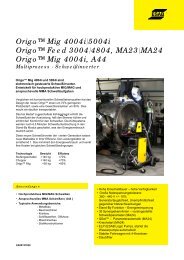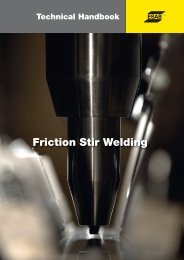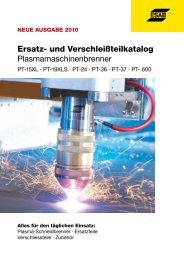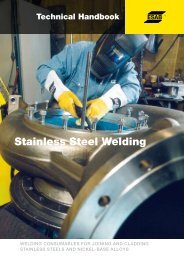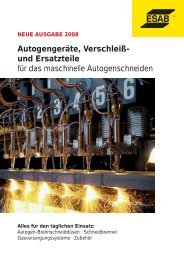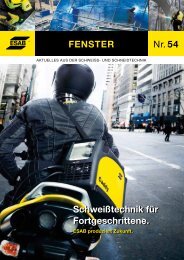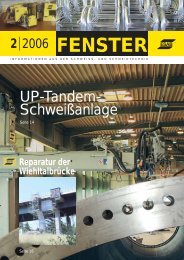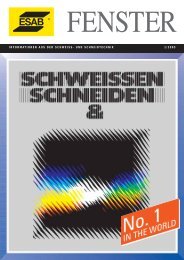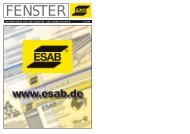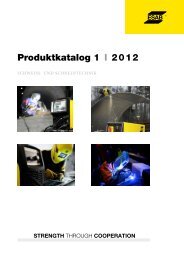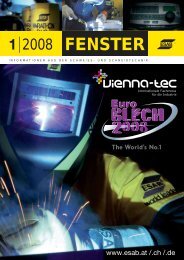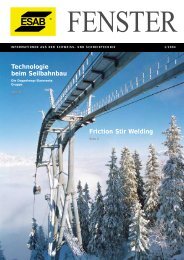Submerged Arc Welding Technical Handbook - Esab
Submerged Arc Welding Technical Handbook - Esab
Submerged Arc Welding Technical Handbook - Esab
Create successful ePaper yourself
Turn your PDF publications into a flip-book with our unique Google optimized e-Paper software.
The submerged arc welding<br />
process<br />
<strong>Submerged</strong> arc welding (SAW) is a<br />
method in which the heat required to<br />
fuse the metal is generated by an arc<br />
formed by an electric current passing<br />
between the electrode and the workpiece.<br />
A layer of granulated mineral<br />
material known as submerged arc<br />
welding flux covers the tip of the<br />
welding wire, the arc, and the workpiece.<br />
There is no visible arc and no<br />
sparks, spatter or fume. The electrode<br />
may be a solid or cored wire or a strip.<br />
SAW is normally a mechanised process.<br />
The welding current, arc voltage, and<br />
travel speed all affect the bead shape,<br />
depth of penetration and chemical<br />
composition of the deposited weld<br />
metal. Since the operator cannot<br />
observe the weld pool, great reliance is<br />
placed on parameter setting and<br />
positioning of the electrode.<br />
General scope:<br />
<br />
range between 100 and 3600 amps<br />
<br />
<br />
<br />
<br />
The welding operation<br />
When the apparatus is set into<br />
operation, several things occur in quick<br />
sequence:<br />
<br />
through the hopper tube and<br />
continuously distributes itself over the<br />
seam a short distance ahead of the<br />
welding zone.<br />
<br />
feed the welding wire into the joint at<br />
a controlled rate<br />
<br />
current flows between the electrode<br />
and the work.<br />
<br />
automatically) to travel along the<br />
seam.<br />
The tremendous heat evolved by the<br />
passage of the electric current through<br />
the welding zone melts the end of the<br />
wire and the adjacent edges of the<br />
work-pieces, creating a pool of molten<br />
metal. The submerged arc welding flux<br />
completely shields the welding zone<br />
from contact with the atmosphere.<br />
As the welding zone moves along the<br />
joint, the fused submerged arc welding<br />
flux cools and hardens into a brittle,<br />
glass-like material which protects the<br />
weld until cool, then usually detaches<br />
itself completely from the weld.<br />
Benefits<br />
<br />
<br />
<br />
<br />
deep and safe penetration<br />
<br />
<br />
<br />
<br />
Limitations<br />
<br />
<br />
<br />
during welding possible<br />
<br />
Equipment – Basic Principles<br />
The high welding speeds and<br />
deposition rates which are<br />
characteristic of submerged arc welding<br />
require automatic control of the motor<br />
that feeds the welding wire into the<br />
weld. No manual welder could smoothly<br />
deposit welding wire at speeds<br />
comparable to those of a submerged<br />
arc welding machine. Nor could he<br />
maintain the same precise control of<br />
welding parameters. The automatic<br />
control and power supply system used<br />
in submerged arc welding operates to<br />
maintain a constant voltage and<br />
current.<br />
Relationship of welding voltage to<br />
distance between welding wire and<br />
work-piece<br />
The welding voltage is proportional to<br />
the length of the current path between<br />
the welding wire and work-piece:<br />
<br />
work-piece increases, the welding<br />
voltage will increase.<br />
<br />
work-piece decreases, the welding<br />
voltage will decrease.<br />
65



